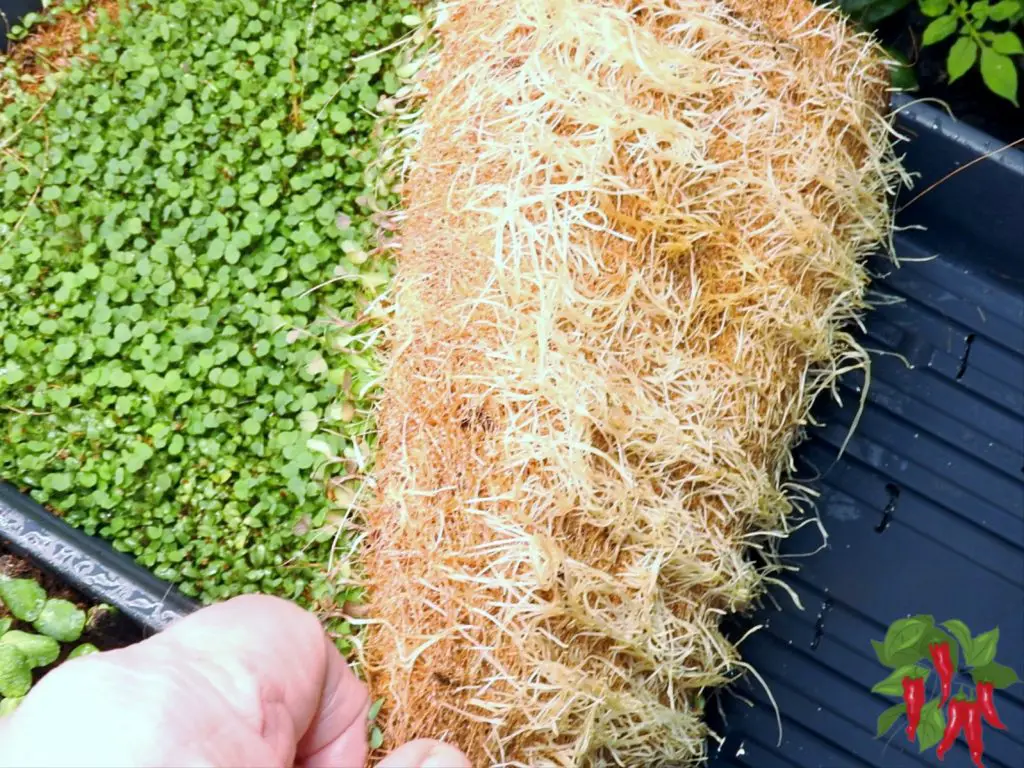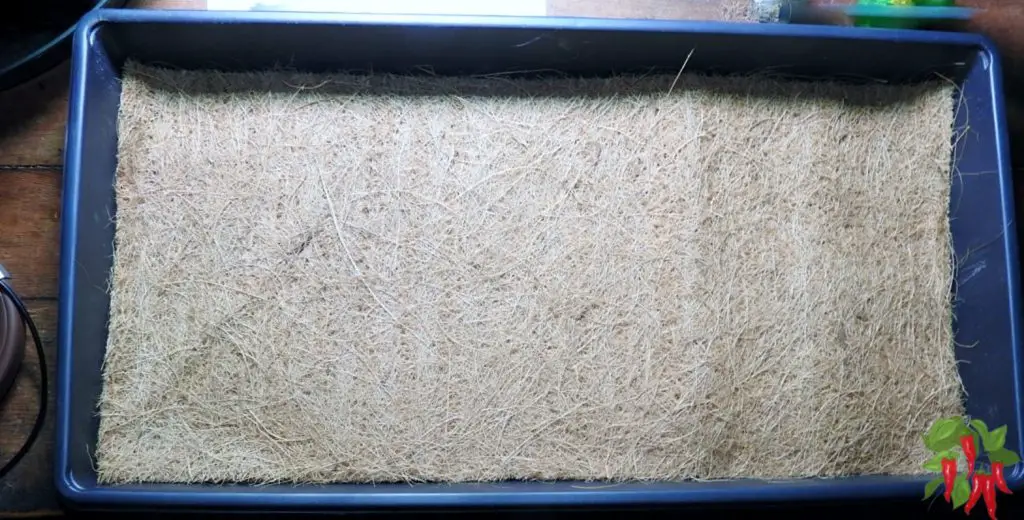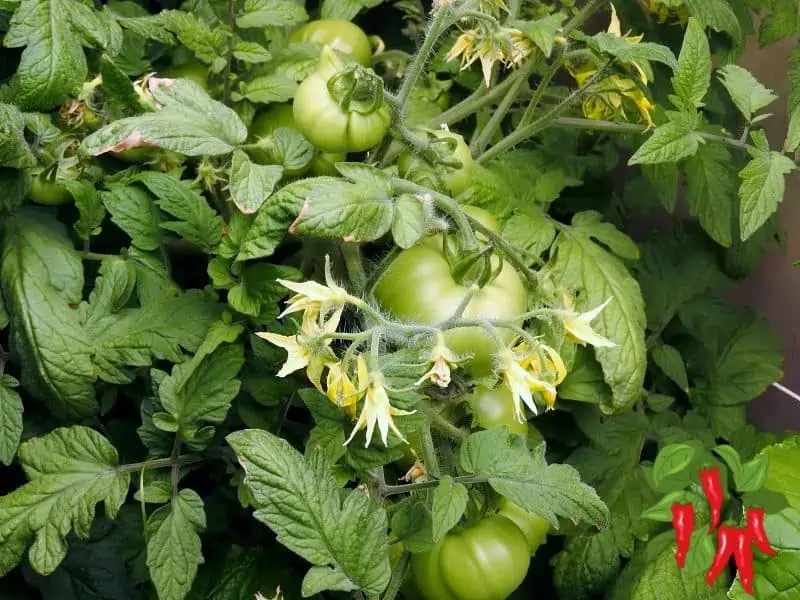This post may contain affiliate links. If you buy something from one of our links we may earn a commission. Thanks

Growing microgreens at home is a fun and rewarding hobby that allows you to enjoy fresh, nutritious greens all year round.
But did you know that you can also learn how to grow microgreens without soil using coco coir grow mats?
We’ll be showing you how to use coco coir growing mats and providing step-by-step instructions for how to grow microgreens without using any soil.
What Are Microgreens?
Microgreens are small, young plants that are typically harvested just a few weeks after germination and before they have their first set of true leaves,
They are typically grown from the seeds of vegetables and herbs and are known for their concentrated flavors and high nutrient content.
They are power packed with nutrients and have a nutritional value that is 4-6 times higher than their mature version.
The researchers looked at four groups of vitamins and other phytochemicals – including vitamin C, vitamin E, and beta carotene — in 25 varieties of microgreens. They found that leaves from almost all of the microgreens had four to six times more nutrients than the mature leaves of the same plant. https://www.npr.org/sections/thesalt/2012/08/29/160274163/
Benefits of growing microgreens at home:
Here are several benefits to growing microgreens at home.
• One benefit is that microgreens are a convenient and easy way to add fresh, nutritious greens to your meals.
• They are also relatively easy to grow, requiring minimal space and effort.
• Additionally, growing microgreens at home allows you to control the quality of the seeds and growing conditions, ensuring that you are getting the most flavorful and nutrient-dense and best microgreens possible.
• Growing microgreens without soil is another way to simplify your growing experience. Soil can be messy to use indoors and you need room to store it.
You also need to dispose of it when you are done. Soilless growing helps solve these problems.

What Are Soilless Growing Methods?
Soilless growing methods simply refer to techniques for growing plants without the use of soil. This is often referred to as hydroponics.
Hydroponic system methods typically involve the use of an alternative growing medium, such as in deep water culture (DWC) using water and nutrients.
Another popular hydroponic method is aquaponics using water and fish waste.
Other methods include using clay pebbles (also called hydroton or LECA) or perlite to support a plant’s roots.
Coconut coir is also considered a hydroponic medium and we can use coco coir grow mats to grow microgreens.
We don’t need to use a nutrient solution since the microgreen seeds themselves provide all the nutrients young microgreen plants need there is no need to fertilize the baby plants.
What we will do is use the mats to provide a base for the microgreen roots to grow into and stay hydrated. So we are really growing hydroponic microgreens.
How To Grow Microgreens Without Soil
Follow this step-by-step guide and you can grow microgreens without soil too.
7 Steps for growing microgreens using coco coir grow mats:
1. Material requirements:
To grow microgreens using coco coir grow mats, you will need a few key materials. These include coco coir grow mats, plastic trays, seeds, and water.
You will also want to have a growing tray or container to hold the grow mat that has drainage holes and a second tray with no holes to be able to bottom water your microgreens.
You may need scissors or a sharp knife to cut the mat to size although many are precut to fit in a 1020 propagation tray.
If you are growing microgreens during the winter months you will need to provide supplemental grow lights.
Because light levels are so low at that time of year you won’t have enough light to grow microgreens and get the best results without them.
2. Setting Up Grow Mats:
Before planting your seeds, you will need to set up the coco coir grow mat. The first thing is to cut the growing pad to fit your soil tray or container.
The grow mats I use are already cut to fit in a 1020 propagation tray.
I use coco grow mats but there are also hemp mats and jute mats available and should also work.
These plastic grow trays can last for years and are really the best way to grow microgreens.
Then I like to soak the mat in tap water for a few hours to allow it to absorb moisture.
My tap water is very clean but most of you will want to use distilled water or set up an RO system.
Chlorine or other impurities can cause problems with young seedlings and most municipal water may also have a very high ph range.
Once the mat is fully saturated the next step is to place it in a tray or container with drainage holes.
3. Planting the seeds:
Once your grow mat is set up, it’s time to plant your seeds. Choose your seeds based on your preferences and the growing conditions in your home.
Some popular choices for microgreens seeds include kale, radish, and cilantro. To plant the seeds, sprinkle them evenly over the surface of the grow mat, making sure to leave enough space between the seeds for them to grow.
Typically you will need one or two tablespoons of seeds for your tray. Most seeds will start to germinate in 3-4 days but some may take longer.
A lot depends on the variety of plants grown and the soil temperature can also affect germination times and rates.
If your growing area is cool using heat mats is a great option to speed up and improve germination
Gently press the seeds into the mat to ensure good contact with the moisture in the mat.
You will want to mist your seeds and place an empty tray on top of your seeds to retain moisture.
When your seeds start to sprout you will want to remove the cover so the photosynthesis process can continue. You will want to continue to mist them daily at this point.
4. Watering and maintaining the grow mat:
Watering and maintaining the grow mat is crucial for the success of your microgreens.
Make sure to keep the mat evenly moist, but be careful not to add too much water as this can lead to mold and other problems.
You can use a spray bottle to mist the mat with water, or you can place the tray inside another similar-sized tray of water to allow the mat to absorb moisture from the bottom. Monitor the mat daily and adjust your watering schedule as needed
5. Tips for success
Choosing the right seeds: When selecting seeds for your microgreens, it’s important to choose varieties that are well-suited to the growing conditions in your home.
Some seeds, such as lettuce and arugula, are more sensitive to temperature and light and may require more careful attention.
Other seeds, such as mustard greens and radishes, are more resilient and can tolerate a wider range of conditions.
Make sure your seeds are organic and non-GMO. Some seeds are treated with chemical fungicides and most bird seed is sterile. Don’t try to use them.
Also do not use seeds like tomatoes or peppers for microgreens because they are in the nightshade family and their leaves are toxic.
Consider the type of microgreens you want to grow, as well as how much space and light you have available when planning your garden and choosing your seeds.
6. Ensuring proper watering and drainage:
Proper watering and drainage are crucial for the success of your microgreens. Overwatering can lead to mold and other problems, while underwatering can cause the seeds to die.
Keep an eye on the moisture level in the grow mat and the water level in the lower tray and adjust your watering schedule as needed.
If you are using a tray or container with drainage holes, make sure to empty any excess water that collects in the bottom to prevent standing water.
7. Controlling temperature and lighting:
Temperature and lighting are two key factors that can affect the growth and development of your microgreens.
Most microgreens prefer a temperature range of 60-70°F, and they will typically need at least six hours of direct sunlight per day.
If you are growing your microgreens indoors, you may need to use grow lights for a supplemental lighting source to provide enough light. You can use fluorescent lights but LED grow lights are a better option.
Adjust the temperature and lighting as needed to ensure that your microgreens are getting the conditions they need to thrive.
Growing Microgreens Without Soil FAQs
Growing microgreens without soil is an exciting and innovative way to enjoy fresh greens at home. But this method might raise some questions, especially if you’re new to soilless gardening. Don’t worry, we’ve got you covered! Below, you’ll find answers to some of the most common questions about growing microgreens without soil. Whether you’re curious about the nature of microgreens or exploring alternative growing methods, these FAQs will guide you through the process.
Q: Are microgreens just baby plants?
A: Yes, microgreens are young plants harvested just a few weeks after germination, before they develop their first set of true leaves. They are known for their concentrated flavors and high nutrient content.
Q: Do microgreens need soil or mat?
A: Microgreens can be grown in soil, but they can also be grown without soil using alternative methods like coco coir grow mats. These mats provide a base for the microgreen roots to grow into and stay hydrated.
Q: What can I use instead of soil for microgreens?
A: Instead of soil, you can use hydroponic mediums like coco coir grow mats, clay pebbles, perlite, or even systems that utilize water and nutrients. These soilless methods offer a clean and efficient way to grow microgreens.
Q: Can microgreens be grown without soil?
A: Absolutely! Microgreens can be grown without soil using various hydroponic methods, including coco coir grow mats. This approach allows for a mess-free and simplified growing experience.
Q: Do microgreens regrow after cutting?
A: Generally, microgreens do not regrow after cutting. They are harvested at a young stage, and once cut, they typically do not produce new growth. It’s best to start with new seeds for each batch of microgreens you wish to grow.
How To Grow Microgreens Without Soil Final Thoughts
Growing microgreens at home is a convenient and easy way to add fresh, nutritious greens to your meals.
It’s also a great way to control the quality of the seeds and growing conditions, ensuring that you are getting the most flavorful and nutrient-dense microgreens possible.
If you’re interested in growing microgreens at home, consider giving the coco coir grow mat method a try.
It’s an easy and effective way to grow microgreens without the need for soil, and the grow mats are readily available and relatively inexpensive.
Once you’ve had success with the coco coir grow mat method, consider experimenting with different seeds and grow mat sizes to see what works best for you.
You can also explore other soilless growing methods, such as hydroponic gardening or aquaponics, to see which method works best for you.
In conclusion, growing microgreens using coco coir grow mats is a simple and rewarding way to add fresh, nutritious greens to your meals year-round.
With the right materials and the information in this article, you can easily set up coco coir grow mats and start growing your own microgreens.
Not only are microgreens delicious and nutritious, but they are also relatively easy to grow, requiring minimal space and effort.
So why not give it a try and see how satisfying it is to harvest your own homegrown microgreens?
Visit my Amazon Influencer Page for videos and gardening products Grow Your Own Garden










